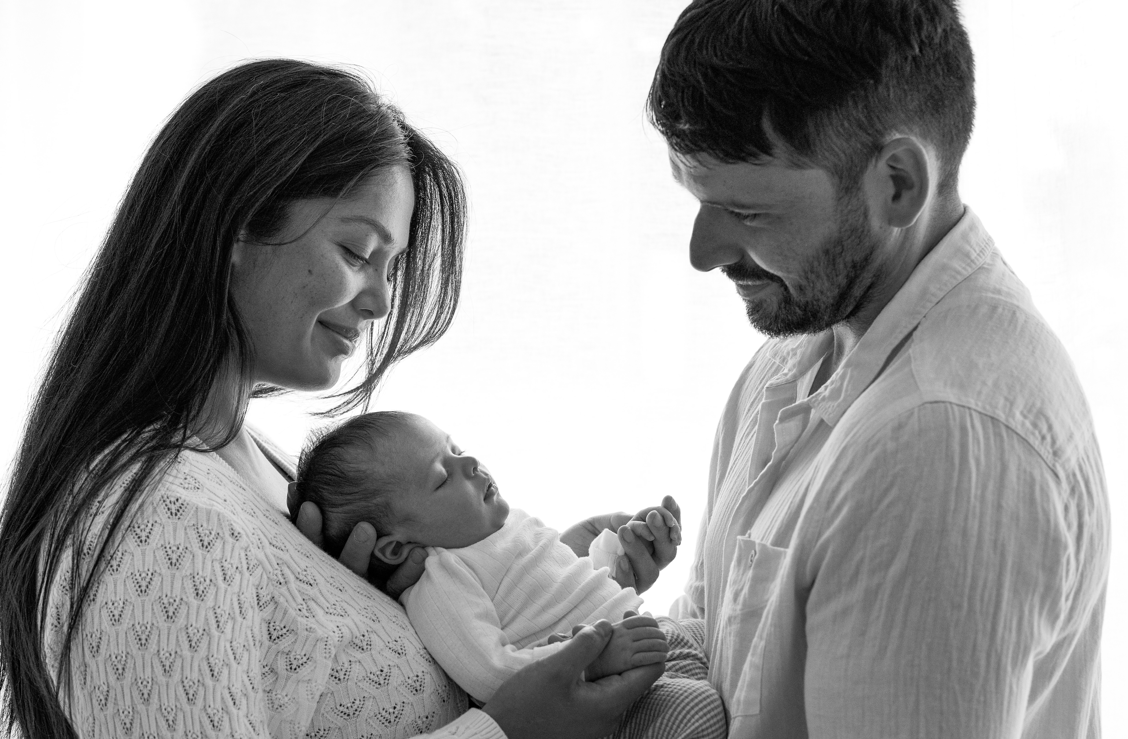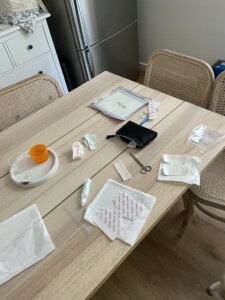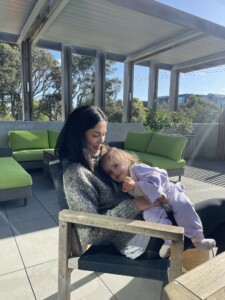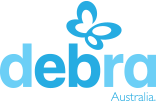
EB AWARENESS WEEK, SANDRA AND ELENA’S STORY
I was born with no skin on my legs, as was my older sister. We believed it was due to a toxin that had got into mum’s liver, causing the missing skin. My mum was treated with natural remedies, and when my younger brother was born without the condition, it solidified the belief that this was what caused it. I grew up with missing toenails, heavy scarring over both legs, constant blisters and skin tears. I had a high pain threshold, and would draw smiley faces on my blisters and push them around – making them bigger. I remember when my wounds would weep, I’d cover them in sand or dirt to dry them up.
We lived on a farm in country Victoria, and the only people who knew about our condition were my parents and grandparents. My scars were my secret, I felt embarrassed and ashamed of them. I wore stockings everyday to school – even on 40C days. When I had an injury, I’d let the wound dry and stick to my stockings so I wouldn’t have to tell anyone. At the end of the day, I’d take my stocking off, and peel my skin off with them. I dreaded swimming days, or sports days.
I was 14 when I first wore short socks to school, and slowly built my confidence to show them as I got older. I found it hard when people would ask me about my scars, because I didn’t know why I looked like this – I only knew that I was “born without skin”. When I was 20, I was at the pool when a stranger asked me about my skin. I told her that I was born with it, and she asked if it was genetic. I had never been asked that before, which is when I deep dove into my medical history, looking for answers. This is when I learned about Epidermolysis Bullosa. Suddenly everything made sense – why I blistered so easily, why I had these scars, why my skin would tear over the smallest of injuries. I felt relieved, until I also realised I had a dominant gene, meaning that I would likely pass the condition onto my child.
 I then spoke to my mum, and learned what she went through. She lived in complete isolation, managing two little babies with wounds and missing skin, with basically no support. She would bathe us in salt, redressing our wounds daily in a way that she taught herself. I learned of my family history, and that it was believed a witch had cursed my family. I understood that my experience of EB growing up was more my mum’s story than mine, because she was the one caring for the worst of it. I cried with my mum, and my appreciation for her grew for how hard this all must’ve been.
I then spoke to my mum, and learned what she went through. She lived in complete isolation, managing two little babies with wounds and missing skin, with basically no support. She would bathe us in salt, redressing our wounds daily in a way that she taught herself. I learned of my family history, and that it was believed a witch had cursed my family. I understood that my experience of EB growing up was more my mum’s story than mine, because she was the one caring for the worst of it. I cried with my mum, and my appreciation for her grew for how hard this all must’ve been.
It wasn’t until four years later that I met with the EB specialists for the first time. Those four years were spent absorbing the information I had learned about the condition, and about myself. I was diagnosed with Dominant Dystrophic EB. I spoke with dermatologists and genetic specialists, and it was then that I truly realised that my mum’s story would become my own. I grieved my idea of an uncomplicated pregnancy and birth, and motherhood journey. I felt guilty that my husband Michael had to go through all of these things, because they were my genes that were faulty, not his.
We fell pregnant 3 months after finalising our genetic counselling. Initially I felt overwhelmed, knowing what would be ahead of us. By 8 weeks into our pregnancy, we were contacted by the hospital – planning for genetic testing. At 10 weeks I had blood drawn to organise the testing. At 12 weeks we had our Chorionic villus sampling (CVS) test. By 16 weeks, we learned that I had passed my EB gene onto our baby.
When the genetic specialist told me the news, I felt numb. Part of me knew, but most of me was hoping that she didn’t. I said, “okay, thank you” and hung up. I sat there, alone in my kitchen at midday, unsure what to do. I called my husband, told him, hung up. I texted Simone from Debra, and then I just cried.
I spent my pregnancy anxious. I felt physically sick, I felt big, and slow, but mostly anxious. I was constantly wondering where she’d be missing skin, if any at all. I wondered if it would be her feet, or her hands, if it’d affect her internal organs. I wondered if she’d suffer, if she’d be in pain. I questioned our future. I winced everytime someone asked if I was having a boy or a girl, because all that was on my mind was whether she’d be okay. I was on the verge of tears at every obstetrician appointment, planning for our daughter’s birth and where she would go afterwards, depending on her presentation. I sat in the unknown, wishing that the CVS gave us more clarity, but all it did was create more questions.
Our birth plan was well documented, meticulously laying out the do’s and don’ts of caring for a newborn with EB. I wanted to avoid a C-section, as the scarring with my EB would re-blister – taking months for me to heal. We planned for no vacuum or forceps, as it would tear our daughters skin. There was to be no rubbing of her skin after birth, just patting, to avoid injury to her.
Elena was born, two hours after arriving at the hospital. She was perfect, I was so in-love. When she was placed on my chest, I felt the relief all mothers feel after going through labour and delivery. I felt a second wave of relief when i looked down and it was *just* her feet that were missing skin. I felt relieved that the wonder and mystery was gone, and I knew what we were dealing with.
When we arrived home, the relief quickly turned back to anxiety when we had to do her daily bleach and salt bath and dressings. This bath time routine would hang over my head until it was complete, knowing and anticipating the pain that she would have to go through. She would kick her legs in pain, and we’d have to hold them apart so they wouldn’t hit each other – tearing more skin off. We were learning how to be parents, while also trying our best to manage all of the things that are EB. Over the following weeks, blisters popped up on her little baby fingers and on her newborn gums. I felt overwhelmed, and guilty, that my gene caused her this suffering. Her pain screams are etched into my heart. I wish my sweet, innocent baby didn’t have to go through the things that she does.
Life now, with a beautiful, busy 18 month old, comes with its challenges. Her birth wounds have healed, but the scars that remain are fragile. Her skin tears off so easily, and it blisters with little knocks – or sometimes it feels like they just come out of nowhere. We try our best to manage her itch, and pain, and the infections that come along with having open wounds and fragile skin. It’s hard with a toddler, because she is so curious and wants to see and play with her toes like the other kids do. She wants to itch because its itchy, but she doesn’t understand that itching just rips her skin off – which can take weeks to heal.
Elena is tough. She is brave, she is the most resilient kid I know. Little falls at the park, or pushes from a friend don’t bother her. She gets right back up again, and I honestly don’t think anything could possibly get in the way of what she wants to do – even if it hurts her. When she’s sore, she likes cuddles and to be close to her parents. She tells you *ow* and shows you where it hurts. She has a missing toe nail now, just like mine, and I love that I can proudly say “mummy’s toes too” when she points at them.
We still do our daily baths, sometimes they have bleach and salt in them if she has an infection or lots of wounds. We still do daily dressings, and pop blisters as we need to with needles. We feel more in control now, and this routine has just become a part of our life. I do find the big injuries and cries upsetting, but I know that I can’t prevent everything, and all we can do is our best.
We were lucky enough to spend the day at Debra’s golf event this year. Michael had fun playing golf, and I spoke at the event, sharing our story about our experience with EB. It always feels good to be around people who understand – especially if Elena is a bit distressed and itching at her feet wounds and blisters.
I work as a Registered Nurse and a model, and am always proud to share our story about EB. I don’t feel ashamed of my skin anymore. I embrace my scars, my wounds, my missing toenails (who needs them) and my deformed finger nail. I feel thankful that my daughter has the support and knowledge that I didn’t have growing up. I feel thankful that I have the support, through Debra and my health care team, that my mum didn’t have on her journey.
